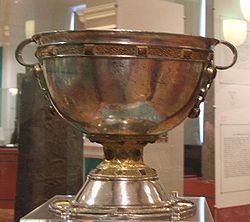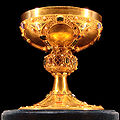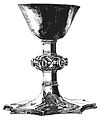- Chalice
-
For other uses, see Chalice (disambiguation)
A chalice (from Latin calix, cup, borrowed from Greek kalyx, shell, husk) is a goblet or footed cup intended to hold a drink. In general religious terms, it is intended for drinking during a ceremony.
Contents
Religious use
Christian
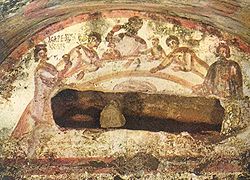 Fresco of a female figure holding a chalice at an early Christian Agape feast. Catacomb of Saints Marcellinus and Peter, Via Labicana, Rome.
Fresco of a female figure holding a chalice at an early Christian Agape feast. Catacomb of Saints Marcellinus and Peter, Via Labicana, Rome.
In Roman Catholicism, Eastern Orthodoxy, Oriental Orthodoxy, Anglicanism, Lutheranism and some other Christian denominations, a chalice is a standing cup used to hold sacramental wine during the Eucharist (also called the Lord's Supper or Holy Communion). Chalices are often made of precious metal, and they are sometimes richly enamelled and jewelled. The gold goblet was symbolic for family and tradition.
The ancient Roman calix was a drinking vessel consisting of a bowl fixed atop a stand, and was in common use at banquets. Chalices have been used since the early church. Because of Jesus' command to his disciples to "Do this in remembrance of me." (Luke 22:19), and Paul's account of the Eucharistic rite in 1 Corinthians 11:24-25, the celebration of the Eucharist became central to Christian liturgy. Naturally, the vessels used in this important act of worship were highly decorated and treated with great respect. A number of early examples of chalices have a large bowl and two handles. Over time, the size of the bowl diminished and the base became larger for better stability. Over time, official church regulations dictated the construction, blessing, and treatment of chalices. Some religious traditions still require that the chalice, at least on the inside of the cup, be made of gold. Modern chalices may be made of clay, wood, glass, or other materials.
In Western Christianity, chalices will often have a pommel or node where the stem meets the cup to make the elevation easier. In Roman Catholicism, prior to Vatican II, chalices tended to be tulip-shaped, and the cups were quite narrow, since normally only the priests would receive the Blood of Christ during Mass. Where all communicants now receive from the chalice, the modern chalices used tend to be larger. Roman Catholic priests will often receive chalices from members of their families when first ordained.
In Eastern Christianity (Oriental Orthodox, Eastern Orthodox and Eastern Catholic churches), chalices will often have icons enameled or engraved on them, as well as a cross. In Orthodoxy and Eastern Catholicism, all communicants receive both the Body of Christ and the Blood of Christ. To accomplish this, a portion of the Lamb (Host) is placed in the chalice, and then the faithful receive Communion on a spoon. For this reason, eastern chalices tend to have larger, rounded cups. In the Russian Orthodox Church, the faithful will often kiss the "foot" (base) of the chalice after receiving Holy Communion. In other traditions, they will kiss the cup. Although Orthodox monks are not permitted to hold personal possessions, the canons permit a hieromonk (i.e., a monk who has been ordained to the priesthood) to keep a chalice and other vessels necessary to celebrate the Divine Liturgy.
In the early and medieval church, when a deacon was ordained, he would be handed a chalice during the service as a sign of his ministry. Early written accounts of the ordination of deaconesses also reflect this practice. In the West the deacon carries the chalice to the altar at the offertory; in the East, the priest carries the chalice and the deacon carries the paten (diskos). Only wine, water and a portion of the Host are permitted to be placed in the chalice, and it may not be used for any profane purpose.
The chalice is considered to be one of the most sacred vessels in Christian liturgical worship, and it is often blessed before use. In the Roman Catholic Church, and some Anglo-Catholic churches, it was the custom for a chalice to be consecrated by being anointed with chrism, and this consecration could only be performed by a bishop or abbot (only for use within his own monastery).[1] Among the Eastern Churches there are varying practices regarding blessing. In some traditions the very act of celebrating the Sacred Mysteries (Sacrament) is the only blessing necessary; in others, there is a special rite of blessing. In some Eastern traditions this blessing may be done only by a bishop, in some it may be done by a priest. In any case, in both the East and the West, once a chalice has been blessed, it may only be touched by an ordained member of the higher clergy (bishop, priest or deacon). In the Russian Orthodox Church a subdeacon is permitted to touch the holy vessels, but only if they are wrapped in cloth.
The Holy Chalice
Main article: Holy ChaliceIn Christian tradition the 'Holy Chalice is the vessel which Jesus used at the Last Supper to serve the wine. New Testament texts make no mention of the cup except within the context of the Last Supper and give no significance whatever to the object itself. Herbert Thurston in the Catholic Encyclopedia 1908 concluded that "No reliable tradition has been preserved to us regarding the vessel used by Christ at the Last Supper. In the sixth and seventh centuries pilgrims to Jerusalem were led to believe that the actual chalice was still venerated in the church of the Holy Sepulchre, having within it the sponge which was presented to Our Saviour on Calvary." Several surviving standing cups of precious materials are identified in local traditions as the Chalice.
Holy Grail
Main article: Holy GrailAn entirely different and pervasive tradition concerns the cup of the Last Supper. In this highly muddled though better-known version, the vessel is known as the Holy Grail. In this legend, Jesus used the cup at the Last Supper to institute the Mass. Other stories claim that Joseph of Arimathea used the cup to collect and store the blood of Christ at the Crucifixion.
Unitarian Universalism
At the opening of Unitarian Universalist worship services, many congregations light a flame inside a chalice.[2] A flaming chalice is the most widely used symbol of Unitarianism and Unitarian Universalism (UU), and the official logo of the Unitarian Universalist Association (UUA) and other Unitarian and UU churches and societies.[3] The design was originated by the artist Hans Deutsch, who took his inspiration from the chalices of oil burned on ancient Greek and Roman altars. It became an underground symbol in occupied Europe during World War II for assistance to help Unitarians, Jews, and other people escape Nazi persecution.[4] The chalice is often shown surrounded by two linked rings The two linked rings were used as an early symbol for the Unitarian Universalist Association, signifying the joining of Unitarianism and Universalism. There is no standardized interpretation of the flaming chalice symbol. In one interpretation, the chalice is a symbol of religion freedom from the impositions of doctrine by a hierarchy and openness to participation by all; the flame is interpreted as a memorial to those throughout history who sacrificed their lives for the cause of religious liberty. In another interpretation, the flaming chalice resembles a cross, symbolic of the Christian roots of Unitarian Universalism.[5]
Wicca
Main article: Magical tools in WiccaIn Wicca a chalice, as a feminine principle, is often used in combination with the Athame (ceremonial black-handled knife), as male principle. Combining the two evokes the act of procreation, as a symbol of universal creativity. This is a symbol of the Great Rite in Wiccan rituals. A chalice is also used in the Small Rite.
Neo-Paganism
Some forms of Neo-Paganism make use of chalices in their rituals as well. A chalice may be placed on an altar or on the ground. The chalice may contain wine, whiskey, water, or other liquids.
Rastafarian
Rastafaris engage in an activity called reasoning. This reasoning helps them shape attitudes towards "politics, theology, repatriation, and reparation."[citation needed] Participants discuss personal issues, but the focus is on the interaction of individuals and society, as well as issues such as ecology.
Such sessions include supervised use of ganja intended to put participants in touch with peaceful feelings, unity, and "consciousness." Rasta philosophy describes ganja-conscious humans "as the temple of God, within which God dwells."[citation needed] Using ganja is said to "stimulate this inner being through spiritual discourse."
In these sessions, ganga is smoked in joints or in a chalice (Waterpipe or bong), although Rasta witnesses said chalice smokers had to be very "mature and clean-spirited" due to the powerful hits delivered by this unique and potent form of inhalation device.
Poisoned chalice
The term "poisoned chalice" is applied to a thing or situation which appears to be good when it is received or experienced by someone, but then becomes or is found to be bad. The idea was referred to by Benedict of Nursia in one of his exorcisms, found on the Saint Benedict Medal: Vade retro Satana! Nunquam suade mihi vana! Sunt mala quae libas. Ipse venena bibas! (Begone Satan! Never tempt me with your vanities! What you offer me is evil. Drink the poison yourself!).
William Shakespeare uses the expression in Act I Scene VII of Macbeth. It occurs in the opening soliloquy of the scene when Macbeth is considering the ramifications of the murder he is plotting.But in these cases
We still have judgment here; that we but teach
Bloody instructions, which, being taught, return
To plague the inventor: this even-handed justice
Commends the ingredients of our poison'd chalice
To our own lips.Heraldry
 Media related to Chalices in heraldry at Wikimedia CommonsMain article: Heraldry
Media related to Chalices in heraldry at Wikimedia CommonsMain article: HeraldryThe use of chalices as heraldic devices is not unusual, especially in ecclesiastical heraldry. A number of cities and regions also make use of the chalice. For instance, the coat of arms of the municipality of Fanas in the district of Prättigau/Davos in the Swiss canton of Graubünden, bears a gold chalice on a solid blue background.
Gallery
-
Ceramic goblet from Navdatoli, Malwa, 1300 BC.
-
Treasure of Gourdon, 6th century AD
-
Tassilo Chalice, c. 780 (reproduction)
-
Ardagh Chalice, 8th century
-
Chalice from Borgå Cathedral (Porvoo Cathedral), c. 1250
-
Baroque chalice with a paten
Slang usage
Main article: Quebec French profanityIn French-Canadian culture, particularly in and around Quebec, the use of the names of holy objects such as "câlice" (a variation of calice, which is the French word for chalice) can be an alternate form of cursing. Somewhat equivalent to the American word "goddam" or the phrase "God damn it", the use of "câlice" or "tabarnak" (a variation of tabernacle) as an interjection is not uncommon in Quebec. For example: "Câlice! I forgot to lock the front door" or muttering "tabarnak" under your breath after you get a flat tire. Presumably a derivation of "taking the Lord's name in vain".[6]
See also
- Ablution in Christianity
- Ardagh Chalice
- Ciborium
- Communion under both kinds
- Corporal (liturgy)
- Derrynaflan Chalice
- Harry Potter and the Goblet of Fire (film)
- Intinction
- The Oxburgh Chalice
- Paten
- Tassilo Chalice
- Treasure of Gourdon
Notes
- ^ Thurston, Herbert (1908), "Chalice", The Catholic Encyclopedia, III, New York: Robert Appleton Company, http://www.newadvent.org/cathen/03561a.htm, retrieved 2008-06-13
- ^ Unitarian Universalist Association of Congregations (March 1, 2007), Our Symbol: the Flaming Chalice, http://www.uua.org/visitors/6901.shtml, retrieved 2007-07-19
- ^ Unitarian Universalist Association,"The History of the Flaming Chalice"
- ^ uuworld.org—liberal religion and life, Wartime origins of the flaming chalice, http://www.uua.org/visitors/6901.shtml, retrieved 2007-07-19
- ^ Unitarian Universalist Association (2007), The History of the Flaming Chalice, http://www.uua.org/aboutuu/chalice.html
- ^ Gordon, Sean (December 12, 2006). "Quebec swears by its English curses: But church-related expletives spoken in French not accepted on TV". Toronto Star
External links
 The Wiktionary definition of chalice
The Wiktionary definition of chalice  Media related to Chalices at Wikimedia Commons
Media related to Chalices at Wikimedia Commons- "Chalice" article from the Catholic Encyclopedia
- Stem glass classification
- Wine Goblets Information Website
Order of the Divine Service in Lutheranism Preparatory Service Entrance hymn and Trinitarian formula (known as the Invocation) · Penitential Rite including the Confiteor and Declaration of Grace (or Asperges on Easter)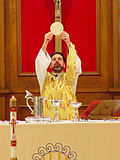
The Service of the Word Introit · Gloria Patri · Kýrie · Gloria · Dominus Vobiscum · Oremus · Collect · Old Testament reading · gradual (or Responsorial Psalm) · Epistle · Alleluia (tract during Lent) · Gospel · Hymn of the day · Homily or Postil (Sermon) · Nicene Creed (Athanasian Creed on Trinity Sunday) · Offertory · Prayers of the FaithfulThe Service of the Eucharist Preface (Sursum corda / Sanctus / Hosanna) · Eucharistic Prayer (Epiclesis / Words of Institution / Memorial Acclamation) · Lord's Prayer · Sign of peace / pax (elevation) · Agnus Dei · Distribution · Nunc dimittis · Postcommunion · Benedicamus Domino · Benediction · Dismissal · Ite missa estParticipants Parts of the Sanctuary altar · altar bell · altar crucifix · altar rails · kneeler · piscina · processional cross · tabernacleCandles Liturgical vessels Liturgical objects collection basket · holy water · incense (use) · paten · sacramental bread (wafer) · sacramental wine · thuribleVestments Liturgical books and hymnals Agenda · Evangelical Lutheran Hymn-Book · Evangelical Lutheran Worship · Lutheran Book of Worship · Lutheran Hymnal · Lutheran Hymnal with Supplement · Lutheran Service Book · Lutheran Worship · Service Book and HymnalCategories:- Chalices
- Drinkware
- Eucharistic objects
- Religious terminology
- Wicca
-
Wikimedia Foundation. 2010.

